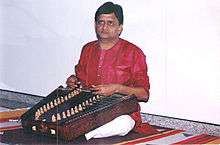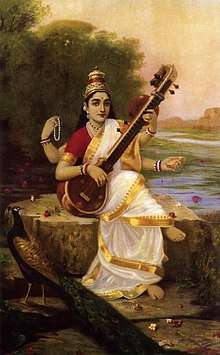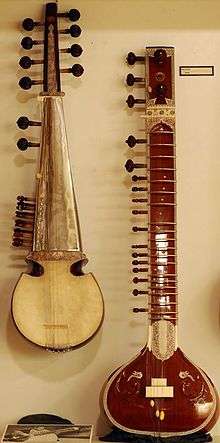Santoor
The Indian santoor instrument is a trapezoid-shaped hammered dulcimer, and a variation of the Iranian Santur.[1] The instrument is generally made of walnut and has 25 bridges. Each bridge has 4 strings, making for a total of 100 strings. It is a traditional instrument in Jammu and Kashmir, and dates back to ancient times. It was called Shatha Tantri Veena in ancient Sanskrit texts.

Development
In ancient Sanskrit texts, it has been referred to as shatatantri vina (100-stringed vina).[2] In Kashmir the santoor was used to accompany folk music. It is played in a style of music known as the Sufiana Mausiqi. Some researchers slot it as an improvised version of a primitive instrument played in the Mesopotamian times (1600-900 B.C.)[3] Sufi mystics used it as an accompaniment to their hymns. In Indian santoor playing, the specially-shaped mallets (mezrab) are lightweight and are held between the index and middle fingers. A typical santoor has two sets of bridges, providing a range of three octaves. The Indian santoor is more rectangular and can have more strings than its Persian counterpart, which generally has 72 strings. Musical instruments very similar to the santoor are traditionally used all over the world.
Characteristics
The trapezoid framework is generally made out of either walnut or maple wood. The top and bottom boards sometimes can be either plywood or veneer. On the top board, also known as the soundboard, wooden bridges are placed, in order to seat stretched metal strings across. The strings, grouped in units of 3 or 4, are tied on nails or pins on the left side of the instrument and are stretched over the sound board on top of the bridges to the right side. On the right side there are steel tuning pegs or tuning pins, as they are commonly known, that allows tuning each unit of strings to a desired musical note or a frequency or a pitch.
Technique
The santoor is played while sitting in an asana called ardha-padmasana position and placing it on top of the lap. While playing, the broad side is closer to the waist of the musician and the shorter side is away from the musician. It is played with a pair of light wooden mallets held with both hands. The santoor is a very delicate instrument and is very sensitive to light strokes and glides. The strokes are played always on the strings either closer to the bridges or a little away from bridges. Both styles result in different tones. Sometimes strokes by one hand can be muffled by the other hand by using the face of the palm just to create variety.
Notable players
- Ulhas Bapat (1950-2018)
- Tarun Bhattacharya (b. 1957)
- Rahul Sharma (b. 1972)
- Shivkumar Sharma (b. 1938)
- Abhay Sopori
- Bhajan Sopori (b. 1948)
- R. Visweswaran (1944-2007)
- Dhananjay Daithankar
- Varsha Agrawal (b. 1967) [4]
- Nandkishor Muley
- Mohammad Tibet Baqal (1914-1982) [5]
- Riz Ram Desad
- Ratanlal Tikoo
- Omprakash Chaurasia
- Harjinder Pal Singh (b.1953) [6]
- Sandeep Chatterjee
References
- Heydarian, Peyman; Reiss, Joshua (2005). Persian Music and the Santur Instrument. Mile End Road, London E1 4NS, UK: University of London. pp. 524–527.CS1 maint: location (link)
- "Magazine / Culture : Santoor magic". The Hindu. 2005-02-27. Retrieved 2012-07-08.
- "How All did the Soporis improvise their Folk instrument". Outlook India. 22 September 2017. Retrieved 14 April 2018.
- https://imcradiodotnet.wordpress.com/2013/01/29/our-wishes-to-indias-single-female-santoor-player-dr-varsha-agrawal-born-29-jan-1967/
- http://autarmota.blogspot.com/2015/04/ustaad-muhhammad-abdullah-tibetbaqal.html
- https://www.swarganga.org/artist_details.php?id=601
External links
| Wikimedia Commons has media related to Indian santoor. |

